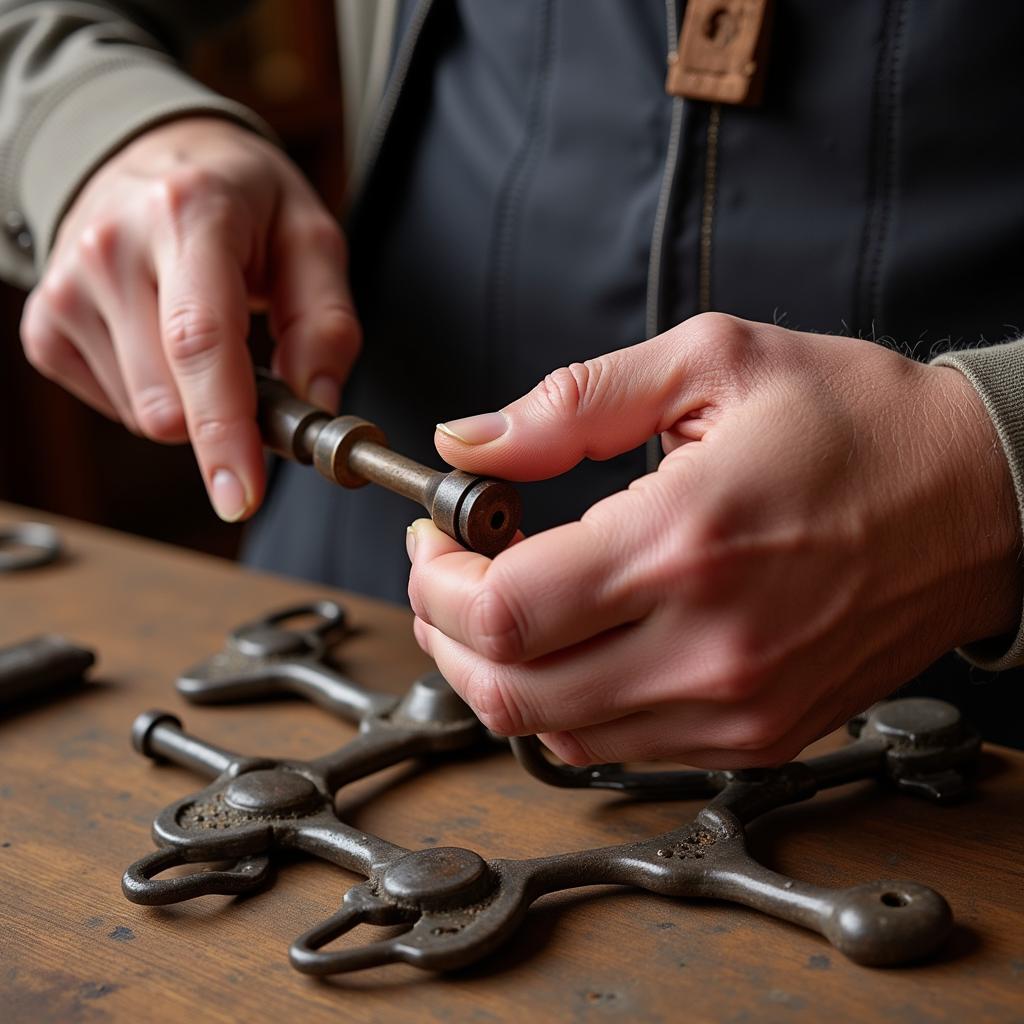Civil War Horse Bits played a crucial role in controlling and directing cavalry horses during the American Civil War. These essential pieces of equipment, often overlooked, were vital for communication between rider and horse in the chaos of battle. Understanding their design and function offers valuable insights into the cavalry tactics and the overall history of this turbulent period.
The Significance of Civil War Horse Bits
Horses were essential for transportation, communication, and combat during the Civil War. Effective control of these animals was paramount, especially in the heat of battle. The bit, the central component of the bridle, acted as the primary interface between rider and mount, allowing for precise commands and maneuvers. A well-chosen bit could mean the difference between a successful charge and a disorganized rout.
Different Types of Civil War Horse Bits
Several distinct types of bits were utilized during the Civil War, each with its own purpose and level of control. The most common were:
- Curb Bits: These bits exerted leverage on the horse’s poll and chin groove, providing significant control and allowing for subtle cues. They were favored for their ability to stop and turn a horse quickly, essential in cavalry charges.
- Snaffle Bits: Snaffle bits applied direct pressure to the corners of the horse’s mouth, offering a gentler, more responsive feel. They were often used for training and for horses requiring less forceful control.
- Pelham Bits: Combining elements of both curb and snaffle bits, Pelham bits offered a versatile option. They provided both direct and leverage pressure, allowing riders to adapt their communication based on the situation.
The Impact of Bit Design on Cavalry Tactics
The design and function of civil war horse bits directly influenced cavalry tactics. The ability to quickly stop, turn, and maneuver horses was critical in the fluid and dynamic nature of Civil War battles. The choice of bit often depended on the specific role of the cavalry unit, whether it be scouting, raiding, or engaging in direct combat.
Identifying and Preserving Civil War Horse Bits
 Identifying Authentic Civil War Horse Bits
Identifying Authentic Civil War Horse Bits
Today, civil war horse bits are valuable historical artifacts, providing a tangible link to the past. Identifying authentic bits requires careful examination, paying attention to details such as material, craftsmanship, and any markings or stamps. Proper preservation techniques are essential for maintaining the integrity of these delicate relics.
Dr. Amelia Cartwright, a renowned equine historian, emphasizes the importance of these artifacts: “Civil War horse bits are more than just pieces of metal; they are windows into the past, offering glimpses into the lives of both the horses and the soldiers who relied on them.” Understanding their significance helps us appreciate the challenges and complexities of mounted warfare during this pivotal period in American history.
Professor John Davies, a specialist in 19th-century military equipment, adds, “The evolution of horse bits reflects the evolving needs of cavalry tactics. The bits used in the Civil War represent a fascinating blend of traditional designs and adaptations made to meet the specific demands of that conflict.”
Conclusion
Civil war horse bits played a crucial role in shaping the course of the American Civil War. These often-overlooked pieces of equipment were instrumental in controlling cavalry horses, influencing tactics, and ultimately impacting the outcome of battles. Studying these artifacts provides a deeper understanding of the logistical and tactical challenges faced by both sides of the conflict.
FAQ
- What were the most common types of bits used during the Civil War? Curb, snaffle, and Pelham bits were prevalent.
- How did bits influence cavalry tactics? They enabled precise control, crucial for maneuvers like charges and retreats.
- Where can I find more information about Civil War horse bits? Museums, historical societies, and online resources offer valuable insights.
- How can I identify an authentic Civil War bit? Look for specific markings, materials, and craftsmanship consistent with the period.
- Why is it important to preserve these historical artifacts? They provide a tangible link to the past, offering insights into the lives of horses and soldiers.
- Are Civil War horse bits valuable? Yes, they can be valuable collectibles, especially rare or well-preserved examples.
- How should I care for a Civil War horse bit if I own one? Consult with a conservator for advice on proper storage and cleaning methods.
Have other questions? Visit our website for more information on civil war horse bit and other related topics.
Need help with your horse or pet? Contact us at Phone Number: 0772127271, Email: [email protected] Or visit us at QGM2+WX2, Vị Trung, Vị Thuỷ, Hậu Giang, Việt Nam. We have a 24/7 customer support team.